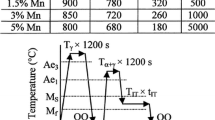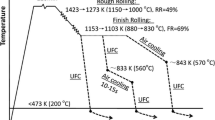Abstract
The effects of the addition of Cr, Mo, and/or Ni on the Charpy impact toughness of a 0.2 pct C-1.5 pct Si-1.5 pct Mn-0.05 pct Nb transformation-induced plasticity (TRIP)-aided steel with a lath-martensite structure matrix (i.e., a TRIP-aided martensitic steel or TM steel) were investigated with the aim of using the steel in automotive applications. In addition, the relationship between the toughness of the various alloyed steels and their metallurgical characteristics was determined. When Cr, Cr-Mo, or Cr-Mo-Ni was added to the base steel, the TM steel exhibited a high upper-shelf Charpy impact absorbed value that ranged from 100 to 120 J/cm2 and a low ductile–brittle fracture appearance transition temperature that ranged from 123 K to 143 K (−150 °C to −130 °C), while also exhibiting a tensile strength of about 1.5 GPa. This impact toughness of the alloyed steels was far superior to that of conventional martensitic steel and was caused by the presence of (i) a softened wide lath-martensite matrix, which contained only a small amount of carbide and hence had a lower carbon concentration, (ii) a large amount of finely dispersed martensite-retained austenite complex phase, and (iii) a metastable retained austenite phase of 2 to 4 vol pct in the complex phase, which led to plastic relaxation via strain-induced transformation and played an important role in the suppression of the initiation and propagation of voids and/or cleavage cracks.















Similar content being viewed by others
References
V.F. Zackay, E.R. Parker, D. Fahr, and B. Bush: Trans. ASM., 1967, vol. 60, pp. 252–59.
K. Sugimoto, J. Sakaguchi, T. Iida, and T. Kashima: ISIJ Int., 2000, vol. 40, pp. 920–26.
T. Hojo, T. Kajiyama, and K. Sugimoto: Proc. Asia Steel Int. Conf. 2009, The Korean Institute of Metals and Materials, Seoul, South Korea, 2009, S7-09.
K. Sugimoto, D. Ina, and J. Kobayashi: Proc. ICAS 2010, Metall. Ind. Press, Beijing, 2010, CD-R.
K. Sugimoto, M. Murata, and S. Song: ISIJ Int., 2010, vol. 50, pp. 162–68.
D.W. Suh, S.J. Park, T.H. Lee, C.S. Oh, and S.J. Kim: Metall. Mater. Trans. A, 2010, vol. 41A, pp. 397–408.
A. Grajcar, R. Kuziak, and W. Zalecki: Arch. Civ. Mec. Eng., 2012, vol.12, pp. 334–341.
H. Aydin, E. Essadiqi, I. Jung, and S. Yue: Mater. Sci. Eng. A, 2013, vol.564, pp. 501–08.
J.G. Speer, D.V. Edmonds, F.C. Rizzo, and D.K. Matlock: Solid State Mat. Sci., 2004, vol. 8, pp. 219–37.
N. Zhong, X.D. Wang, L. Wang, and Y.H. Rong: Mater. Sci. Eng. A, 2009, vol. 509, pp. 111–16.
X.D. Wang, N. Zhong, Y.H. Rong, T.Y. Hsu, Z.Y. Xu, and L. Wang: J. Mater. Res., 2009, vol. 24, pp. 260–67.
K. Sugimoto and J. Kobayashi: Proc. MS&T 2010, TMS, Warrendale, PA, 2010, pp. 1639–49.
J. Kobayashi, D.V. Pham, and K. Sugimoto: Steel Res. Int., 2011, Special Edition: ICTP2011, pp. 598–603.
M.A. Grossman: Trans. AIME, 1942, vol. 150, pp. 227–59.
J.H. Hollomon and L. D. Jaffe: Trans. AIME, 1946, vol. 167, pp. 601–16.
H. Maruyama: J. Jpn. Soc. Heat Treat., 1977, vol. 17, pp. 198–204.
D.J. Dyson and B. Holmes: J. Iron Steel Inst., 1970, vol. 208, pp. 469–74.
S. Song, K. Sugimoto, M. Kobayashi, H. Matsubara, and T. Kashima: Tetsu-to-Hagane, 2000, vol. 86, pp. 563–69.
R.M. Horn and R.O. Ritchie: Metall. Trans. A, 1978, vol. 9A, pp. 1039–53.
M. Sarikaya, A.K. Jhingan, and G. Thomas: Metall. Trans. A, 1983, vol. 14A, pp. 1121–33.
G.E. Dieter: Mechanical Metallurgy (SI Metric Edition), McGraw-Hill Book Co., London, U.K., 1988, pp. 262–65.
F.A. McClintock: J. Appl. Mech., 1968, vol. 35, pp. 363–71.
T. Kunitake, F. Terasaki, Y. Ohmori, and H. Ohtani: Toward Improved Ductility and Toughness, Climax Molybdenum Develop. Co., Kyoto, Japan, 1971, pp. 83–100.
Acknowledgments
This study was supported by Grants from the Adaptable and Seamless Technology Transfer Program through Target-driven R&D, the Japan Science and Technology Agency.
Author information
Authors and Affiliations
Corresponding author
Additional information
Manuscript submitted February 27, 2013.
Rights and permissions
About this article
Cite this article
Kobayashi, J., Ina, D., Nakajima, Y. et al. Effects of Microalloying on the Impact Toughness of Ultrahigh-Strength TRIP-Aided Martensitic Steels. Metall Mater Trans A 44, 5006–5017 (2013). https://doi.org/10.1007/s11661-013-1882-9
Published:
Issue Date:
DOI: https://doi.org/10.1007/s11661-013-1882-9




